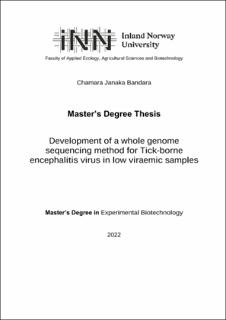| dc.description.abstract | Due to the rapid increase in Tick-Borne Encephalitis (TBE) viral infections in Norway and in the Western Europe, attentions have been drawn to develop rapid screening and whole genome sequencing methods directly from the tick samples. This would facilitate the identification of Tick-Borne Encephalitis virus (TBEV) endemic area, to predict the neuroinvasive ability and the disease severity of the TBEV natural foci.
In this study, the optimization of RT-PCR, PCR and the whole genome sequencing with Oxford Nanopore technology (ONT) were carried out using tenfold dilutions of total RNA extract of Vero E6 cell culture sample incubated with TBEV-Hochosterwitz strain (NCBI Acc. No. MT311861). Total of 172 tick samples, including nymph pools of ten nymphs per pool (76) and adult males (50) and adult females (46) were collected from Larvik, Norway and separately subjected to total RNA extractions and evaluated for TBEV using two separate semiquantitative real-time PCR techniques. Whole genome amplifications and Oxford Nanopore sequencing and reference-based mapping were carried out for the TBEV positive tick RNA samples against the best optimized primer schemes. Phylogenetic tree analysis was carried out for the TBEV genome sequence fragments to identify the evolutionary closest TBEV subtype. In addition, TBEV positive tick species were identified using 18S-rRNA sequences found in Oxford Nanopore reads by phylogenetic tree analysis.
TBEV positive five nymph tick pools, five female and three male adult ticks were identified and the prevalence of TBEV at the study site found to be 0.68 ± 0.30%, 10.90% and 6.00%, respectively. Primer schemes {[(2E+2Q)+(2F+2R)] and [(G+S)+(H+T)]} were identified as suitable for the whole genome amplification of TBEV directly form the tick samples. The maximum average sequencing breadth over 20 reads and the sequencing coverage were fell below the 13.6% and 50.56%, respectively in the reconstructed TBEV genomes. All the TBEV genomic sequence fragments shown to have close evolutionary relationship to the TBEV-European subtype and the TBEV positive ticks were identified as Ixodes ricinus.
The optimized primer schemes exhibited whole genome amplification ability over the low viraemic TBEV positive tick samples and having sequencing gaps in the reconstructed genomes. Further optimizations are necessary to improve the quality of the reconstructed TBEV genomes directly from the tick samples and which will lead to improve the accuracy in the predictions of the neuroinvasive ability of the TBEV strains. | |
